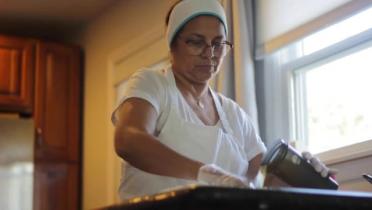Dia de los Muertos Ofrenda/Day of the Dead Ofrenda
Porfiria Mijangos explains the elements of a traditional ofrenda for Day of the Dead in her region of Oaxaca, Mexico. Interview and footage are from the Day of the Dead celebration at Orleans YMCA, Medina, New York, November 1 2019. Members of her extended family built the large ofrenda seen here for the annual community-wide event.
Ofrendas (literally offerings) are a central component to Day of the Dead celebrations in Mexico. Many families traditionally maintain a small altar in their home throughout the year for personal devotions. These may be expanded for the Dia de Muertos, or a separate, elaborate ofrenda is built. Mexican regional geography varies widely, including desert, mountain, tropical, coastal, plains and rainforest environments. Regional ofrendas reflect these regional climates through the natural flora and resources they use, resulting in very diverse styles from one region to the next. The arch used in the Oaxaca ofrenda, for example, is not universal: some coastal regions feature palm fronds woven into crosses or flowers; others may use extensive fabric draping or even incorporate a hanging altar.
Porfiria explains more about how she and her community celebrate after November 2, and what happens to the ofrenda:
[On November 2] everyone has left, the incense is extinguished. All the souls have gone. So then, the party is for us. Close friends and godparents will visit each other at home. I have several goddaughters from baptism, so their parents will invite me to their homes. We’ll have hot chocolate and bread. They’ll give me bread, and a meal. And then I’ll tell them, “I’ll be expecting you tomorrow.” And I’ll spend time with my friends and neighbors, drinking hot chocolate, eating, talking, making toasts to each other with mescal or a beer. But not a lot, just a little, enough to enjoy talking and being together. And so we talk, we have conversations, we visit each other’s homes. I invite my family to come, and they invite me, and we visit each other. And so we go from the souls of the children, then to those of the adults, and then to the celebration for us, the living. We’ll drink chocolate, for eight days, until the eighth day, which we call the octavo. It’s the last night that we’ll drink hot chocolate, go and eat at each other’s houses, to visit, to have a drink, because it’s about to end.
And we’ll still have the arch with the flowers [in the ofrenda]. Nothing left on the altar is eaten, not the one or two pieces of bread, nothing. We take down the flowers from the altar and bury them. The altar is up for eight days, but only with the flowers, the flowers that we put there from All Saints, we leave, but the fruit, we take away. We take away the fruit so that it doesn’t—it will start to turn, yes? So, after the festival of the children’s souls and the adults is over, we take down the fruits and bury them. We bury them so they don’t go bad, get eaten by flies and mosquitos. We bury them, and after burying them there are only flowers left on the ofrenda until the eighth day, and then we take down the arch and all the flowers, which have become dry. And, if we want, we can scatter them on the ground nearby, or bury them also. That’s what we do.

